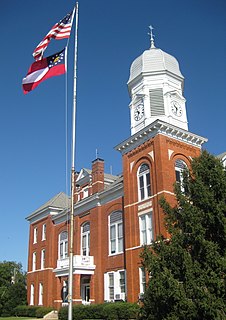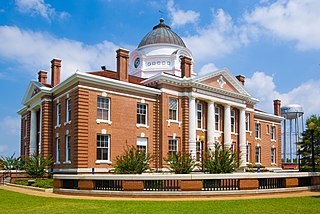
Henry County is located in the north central portion of the U.S. state of Georgia. Per the 2010 census, the population of Henry County is 203,922. The county seat is McDonough. The county was named for Patrick Henry.

McDonough is a city in Henry County, Georgia, United States. It is part of the Atlanta metropolitan area. Its population was 22,084 at the 2010 census, up from 8,493 in 2000. The city is the county seat of Henry County.

The Old Baker County Courthouse built in 1908, is an historic building located at 14 McIver Avenue West in Macclenny, Florida. It was designed by Edward Columbus Hosford of Eastman, Georgia. In 1986 it was added to the U.S. National Register of Historic Places.

The McDonough County Courthouse is located in the McDonough County city of Macomb, in the U.S. state of Illinois. The courthouse was constructed in 1871. Architect Elijah E. Myers designed the building in the Second Empire style; the courthouse is one of the few remaining Second Empire buildings in the United States.
William Augustus Edwards, also known as William A. Edwards was an Atlanta-based American architect renowned for the educational buildings, courthouses and other public and private buildings that he designed in Florida, Georgia and his native South Carolina. More than 25 of his works have been listed on the National Register of Historic Places.

The Bulloch County Courthouse is a historic courthouse that is located in downtown Statesboro, Georgia. It was built in 1894 to house the county government. On September 18, 1980, the building was added to the National Register of Historic Places.
Henry County Courthouse may refer to:

The Butts County Courthouse is an historic former government building designed by Bruce & Morgan and constructed in 1898 by J.H. McKenzie & Son in Jackson, Butts County, Georgia, United States.

Globe Hotel in McDonough, Georgia, USA, also known as Dunn House, was built in 1827 and expanded in the late 1800s. It is a two-story frame building. In the 1930s, the building was moved about one block from its original location facing the courthouse square. It has some elements of Stick/Eastlake architecture in the newer section.
Joseph Henry Wohleb (1887–1958) was an American architect from Washington. He was born in Waterbury, Connecticut, and grew up in California. He is known for the design of classic motion picture theaters in the 1920s. He was also the designer of Cloverfields in Olympia, a farmhouse listed on the National Register of Historic Places. Also, he served as the architect for the Washington State Capitol Museum and other buildings on the Washington State Capitol Campus.

The second Taliaferro County Courthouse is an historic courthouse building located in Crawfordville, Georgia. Designed by Lewis F. Goodrich in the High Victorian style, it was built in 1901–1902 by J.H. McKenzie & Son on the site of the first Taliaferro County Courthouse (1828) which had been demolished to make way for it.

Bruce & Morgan was an architectural firm in Georgia. It was a partnership during 1882 to 1904 of Alexander Bruce (1835-1927) and Thomas Henry Morgan (1857-1940.

James Wingfield Golucke (1865–1907), often known as J.W. Golucke, was an American architect based in Atlanta, Georgia.

Ben Hill County Courthouse is the historic county courthouse of Ben Hill County, Georgia, located in Fitzgerald. It was added to the National Register of Historic Places on September 18, 1980. It is located at East Central Avenue at South Sheridan Street.

The Early County Courthouse is the historic county courthouse of Early County, Georgia, located on Courthouse Square in Blakely, Georgia, the county seat. It was built in 1904 and added to the National Register of Historic Places on September 18, 1980. It is also a contributing building in the Blakely Court Square Historic District, NRHP-listed in 2002.

Glascock County Courthouse is a courthouse on Main Street in Gibson, Georgia, the county seat of Glascock County. The first county courthouse was built in 1858 with a donation from William Gibson, namesake of the county seat. It was removed for use as a residence when the currently used courthouse was built in 1919. The courthouse was designed by J.W. McMillian & Son. It was added to the National Register of Historic Places on September 18, 1980.

The Telfair County, Georgia Courthouse in McRae-Helena was built in 1934 using the walls of the previous courthouse, lost to fire earlier that year. It was designed by architects Dennis & Dennis. The nearby Telfair County Jail was built in 1902. The courthouse and jail were added to the National Register of Historic Places in 1995.

The McDonough Historic District, in McDonough, Georgia, is a 200-acre historic district which was listed on the National Register of Historic Places in 2007. It is centered on Griffin St. and Keys Ferry St. and has buildings dating back to 1823. The district includes 187 contributing buildings, one contributing structure, one contributing site, and a contributing object, as well as 71 non-contributing buildings.

The Lawrenceville Street Historic District, in McDonough, Georgia, is a 25 acres (10 ha) historic district which was listed on the National Register of Historic Places in 2009. It included 27 contributing buildings and a contributing structure.


















